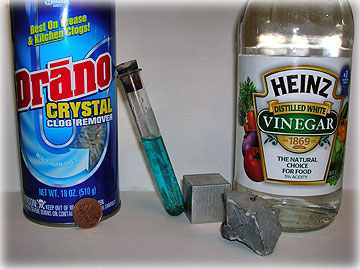 by Preston MacDougall October 16, 2006
The television show "Trading Spouses" must be a "fair and balanced" depiction of the lives of some American families - after all, it's on Fox. There is no question, however, that it perfectly imitates an atomic dance step that commonly occurs in chemistry - the double-exchange reaction.
In this kind of reaction, the positive and negative components of two compounds "swap" partners, and there are observable consequences of one, or both, of the new couplings. For instance, limestone is a mineral made of positive calcium ions and negative carbonate ions. It is rock stable. Acetic acid is a compound of hydrogen ions and acetate ions - positive and negative, respectively. Vinegar is a solution of acetic acid in water. Put a small piece of limestone in a cup of white vinegar and watch what happens. Bubbles will start to form on the rock, and they're not coming from the vinegar, but from the rock! What's happening is that the limestone and the acetic acid are switching partners at the rock's surface. Since opposites attract in chemistry as in life, calcium pairs with acetate and hydrogen pairs with carbonate. The latter produces carbonic acid, which quickly breaks apart into a water molecule and a molecule of carbon dioxide. Some of the CO2 will remain dissolved, but the once-staid rock will start to blow bubbles. Other carbonate minerals, such as Siderite (a compound of iron and carbonate ions) will undergo the same reaction with other acids, such as the citric acid in lemon juice. All organic acids have the capacity to exchange a positive hydrogen ion, and this is where their "tartness" comes from. Not all exchange reactions are imitated by the "Trading Spouses" show, however. Single-exchange reactions are atomic dance steps that involve replacement of just one of the elements in a compound by another element. For instance, silver nitrate is a compound that is used to prevent blinding bacterial infections in the eyes of newborns. It is the active ingredient that is dissolved in the eye drops that are quickly administered after birth. I was present for the births of all my children, and they were each miraculous events. At the time, I wasn't really interested in the chemistry of the eye-drops, and there were too many teardrops in my own eyes to make any careful observations anyway. But every year when I demonstrate single-exchange reactions in my chemistry class, I go with silver nitrate. If anything made of copper is dropped in the clear and colorless silver nitrate solution, a beautiful reaction occurs. The surface of the copper immediately becomes silver-plated and soon sprouts crystalline branches of pure, shiny silver. What's happening is that the metallic copper atoms are "Trading Spaces" with the positive silver ions in the solution, resulting in crystal branches of metallic silver and positive copper ions being released into the solution. The negative nitrate ions are still there, and the new compound, copper nitrate, gives the solution a lovely turquoise blue color. You don't have to be an Ob/Gyn to observe this atomic dance step. The same type of reaction can be performed with commonly available materials. Although it isn't as beautiful as the formation of crystal silver branches, it is actually more mysterious from a chemist's point of view. Drano Crystal clog remover has two active ingredients, which can easily be separated with tweezers. (Avoid skin contact, and dispose as if you had a clogged drain.) The shiny "crystals" are just shavings of aluminum. The bluish pellets are mostly sodium hydroxide, which is also called "lye" or "caustic soda". Drano "cuts through clogs" by reacting with grease, making soapy molecules in the deal. But that's not the chemistry of interest, unless you have a clogged drain, that is. If you separate the crystals from the pellets in different containers, and add water to both, nothing much happens. Some of the pellets will dissolve, warming the solution, but the crystals just sit there. Now combine the mixtures. Slowly, aluminum starts to blow bubbles. Interestingly, the aluminum atoms do not exchange places with the positive sodium ions in the caustic soda. They are essentially "Trading Spaces" with hydrogen ions that are fleetingly present even in the purest water, releasing hydrogen gas in the deal. You might be wondering; "If aluminum can react with hydrogen ions, then why doesn't plain water react with aluminum cans?" Good question. The answer is it would if it could. Aluminum is in fact a very
reactive metal. However, it immediately reacts with oxygen in
the air to form an ultra-thin protective coating of aluminum
oxide, which is very inert. Somehow the hydroxide ions in the
caustic solution remove this protective layer, exposing the pure
aluminum to the water, so the show can go on, as it must.
On the Web:
Publish A Letter on SitNews Read Letters/Opinions Submit A Letter to the Editor
|
||
